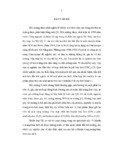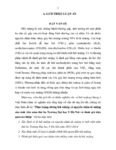
Please use this identifier to cite or link to this item:
http://dulieuso.hmu.edu.vn/handle/hmu/1713| Title: | Thực trạng hôi miệng có nguyên nhân từ miệng của sinh viên năm thứ ba Trường Đại học Y Hà Nội và đánh giá hiệu quả can thiệp |
| Authors: | Hoàng Kim, Loan |
| Advisor: | PSG.TS Trương Mạnh, Dũng |
| Keywords: | 62720601;Răng – Hàm – Mặt |
| Abstract: | THÔNG TIN TÓM TẮT VỀ NHỮNG KẾT LUẬN MỚI . CỦA LUẬN ÁN TIẾN SĨ. Những kết luận mới của luận án:. - Phát hiện tỷ lệ mắc chứng hôi miệng có nguyên nhân từ miệng của sinh viên năm thứ ba Trường Đại học Y Hà Nội là khá cao, trong đó tỷ lệ hôi miệng trung bình là cao nhất (49,4%), hôi miệng nhẹ (30,6%) và hôi miệng nặng là 20%, nam chiếm 57,8%, cao hơn so với nữ (42,2%).. - Nguyên nhân chính gây hôi miệng ở sinh viên là mảng bám lưỡi (95,6%) và cao răng (93,9%). Có 66,1% sinh viên bị sâu răng và 55% có mảng bám răng.. - Đây là nghiên cứu đầu tiên của Việt Nam xác định được một số vi khuẩn có liên quan đến hôi miệng. Nghiên cứu này mở ra một hướng mới trong việc xác định vai trò của vi khuẩn với hôi miệng, từ đó có những biện pháp điều trị và phòng bệnh thích hợp.. - Nghiên cứu đã thu được 20 loài vi khuẩn thuộc 04 chi: Chi Streptococcus, chi Veillonella, chi Neisseria, chi Haemophilus.Có 4 loài hay gặp là Streptococcus salivarius (40%), Veillonella sp (30%), Streptococcus parasanguinis (23,33%), Streptococcus oralis (20%).. - Sự kết hợp của biện pháp cơ học (chải răng, cạo lưỡi) và biện pháp hoá học (dùng NXM) có hiệu quả tăng cường vệ sinh răng miệng, làm sạch mảng bám lưỡi và giảm mức độ hôi miệng.. - Tỷ lệ sinh viên đạt hiệu quả điều trị tốt sau 6 tháng ở nhóm can thiệp là 71,9%, ở nhóm chứng là 52,2%.. SUMMARY OF NEW FINDINGS OF DOCTORAL THESIS. New findings of the thesis:. - Finding that the percentage of halitosis causing from oral cavities of the third-year students of Hanoi Medical University is rather high, in which the medium halitosis percentage is highest (49,4%), light halitosis (30,6%), and heavy halitosis is 20%, men occupy 57,8%, are higher than women (42,2%).. - The main reasons causing students’ halitosis are tongue coating (95,6%), and tartar (93,9%). There are 66,1% of students having dental caries, and 55% of students having dental plaque.. - This is the first research of Vietnam, that has identified some bacteria having relation with halitosis. The research opens a new way of identifying the roles of bacteria in causing halitosis, so that we can apply appropriate treatment and prevention measures.. - The research has collected 20 kinds of bacteria belonging 4 species:Streptococcusspp, Veillonellaspp,Neisseriaspp,Haemophilusspp.There are 4 popular species, including:Streptococcus salivarius(40%), Veillonella sp(30%),Streptococcus parasanguinis(23,33%),Streptococcus oralis(20%).. - The combination between mechanical methods (teeth brushing, tongue cleaning) with chemical method (using mouth rinse) brings the effects of improving oral hygiene, cleaning tongue coating and reducing halitosis level.. - The percentages of students having good treatment effectiveness among intervention group after six months are 71,9%, and 52,2% among the controlled group after six months.. |
| URI: | http://dulieuso.hmu.edu.vn//handle/hmu/1713 |
| Appears in Collections: | Luận án (nghiên cứu sinh) |
Files in This Item:
| File | Description | Size | Format | |
|---|---|---|---|---|
| 106_Toan van- Loan.pdf Restricted Access | 22.53 MB | Adobe PDF |  Sign in to read | |
| 106_24- Loan.pdf Restricted Access | 1.01 MB | Adobe PDF |  Sign in to read |
Items in DSpace are protected by copyright, with all rights reserved, unless otherwise indicated.